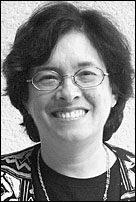| |
Anat Geva cited for
teaching excellence
 Assistant professor of architecture honored by
Montague Center for Teaching Excellence
Assistant professor of architecture honored by
Montague Center for Teaching Excellence
| |
|
Anat Geva, assistant professor of architecture at Texas A&M University, was named the 2002-03 Montague Center for Teaching Excellence Scholar for the College of Architecture.
The program, established in 1991 by A&M's Center for Teaching Excellence, was created to stimulate the development of innovative teaching strategies and technologies and to recognize those A&M faculty members who excel in teaching early in their career.
Geva received a doctorate in Architecture from Texas A&M in 1995 after joining faculty in 1991. She earned a Master of Architecture degree from Ohio State University in 1975 and a bachelor's degree in architecture and city planning from the Technion - Israel Institute of Technology in 1973.
Geva's areas of interests include architectural design, historic buildings and climate, sacred architecture, history of building technology, and Frank Lloyd Wright's sacred architecture. She is also a Faculty Fellow of the College of Architecture's Historic Resources Imaging Lab and the Historic Preservation Program.
Among other honors Geva has earned while at A&M is the 1997 James Marston Fitch Award for her project, "Frank Lloyd Wright's Architecture: A Computerized Energy Simulation Study." She was also awarded the William W. Caudill Graduate Research Fellowship in 1994, an award given for the best dissertation proposal in the College of Architecture.
The Montague Center Award is named for the late Kenneth E. Montague, a 1937 Texas A&M graduate who in 1991 began a fund to identify scholars who embrace the values of excellence in instruction and commitment to students.
One Montague Center for Teaching Excellence Scholar is selected annually to represent each A&M college. The scholars receive a $5,000 grant to research and develop innovative teaching techniques. Additionally, the scholars meet with university administrators to discuss the professor's role as a teacher and to encourage commitment to innovative classroom teaching.
| |

 Anat
Geva
Anat
Geva
|
|
| |
|
|